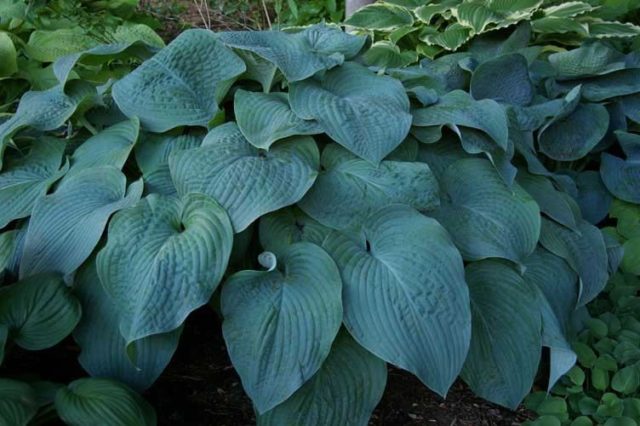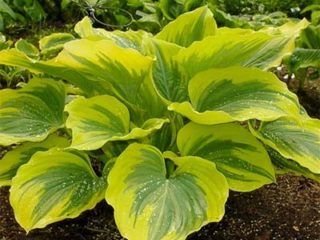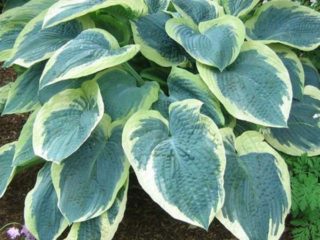Content
Hosta Siebold is an amazingly beautiful perennial plant. It is ideal for decorative landscaping in gardens, personal plots, as well as for lawns and the coastal zone of reservoirs.

Hosta Siebold has an unusual appearance due to textured large leaves
Description of Hosta Siebold
The hosta garden plant is a perennial and belongs to the Asparagus family. Japan (the island of Honshu) is considered to be its homeland, where this plant can be found in the wild; in addition, it is found in the Far East and East Asia. Hosta Siebold received its name in honor of the botanist and researcher Philip Siebold. The plant was first brought to Europe in the 18th-19th centuries. Today, hosta is used everywhere to decorate flower beds, garden beds, and bushes are planted around ponds, at the base of alpine hills, and in other areas where many plants do not take root well.
The first 2 years after planting the Siebold host develops slowly, but in the 3-4th year its growth accelerates. During this same period, the seasonal change in leaf color begins. The plant begins to show decorative qualities by the age of 4, and by 8-10 years it fully reveals its splendor.
In appearance, the shrub is quite large with wide and dense leaves. Their color is deep green with a bluish waxy coating, and their shape is heart-shaped. Due to the fact that the color has a bluish-gray tint, the plant is classified as a blue hosta. The surface of the leaf is ribbed to the touch, it is about 30 cm long and up to 25 cm wide.
Hosta Siebold blooms in early July; the inflorescences are practically invisible behind the large greenery. The flower stalks themselves reach a height of no more than 40 cm, have practically no leaves, the flowers are light lilac in color, funnel-shaped or bell-shaped. At the end of flowering, triangular small boxes with black seeds inside ripen. The rhizome is compact, short and has few branches.

The peduncles reach 6 cm in length and their tops are abundantly crowned with pale lilac flowers
The plant itself is unpretentious in care and has a fairly high degree of winter hardiness. Calmly withstands frosts down to -35 degrees without shelter.
Hosta Siebold is a shade-loving plant, but it can also grow in a bright area, provided that it receives direct sunlight for no more than 1-2 hours a day. With prolonged exposure to the scorching sun, the leaves will not have a bluish coating, but will become dark green.
Application in landscape design
Hosta Siebold is considered a universal plant in landscape design. It is used both to create independent compositions and in combination with other colors.
It looks great in a flower bed with various ground cover and low-growing plants (daylily, viola, primrose, bergenia, daisies). Compositions are often planted where the following plants take root well together with the hosta:
- prima;
- sedum (sedum);
- fern;
- iris;
- spurge;
- corydalis;
- thuja;
- bells;
- peonies.
And this is not the entire list of suitable plants for planting together with Siebold’s hosta. It also goes well with conifers and cereals.

Hosta Siebold in a successful garden composition with various flowers

Small flowerbed with sedums and peonies

Hosta Siebold Elegant in combination with fern against the backdrop of flowering bright plants
Varieties
Hosta Siebold has several varieties. The most popular hybrid varieties of this plant were bred in Japan. They differ from each other in height, as well as in leaf size.
Francis Williams
Hosta Siebold Frances Williams is an unpretentious variety, frost-resistant and suitable for growing in any type of soil. High resistance to various diseases is also noted.
A plant of this variety is recommended for planting in partial shade, but the place should be protected from the wind, as large leaves can be damaged.
Hosta Siebold Frances Williams is described as a medium-growing perennial shrub, reaching 65 cm in height. The leaves are large, round, azure blue with a yellow border along the edges.
Blooms in mid-summer (June-July), short stalks with white flowers. Their diameter is up to 5 cm, they form brushes of 8 pieces.

The leaves have an attractive two-tone color
Elegance
Hosta Siebold Elegance is quite large in size. The bush can reach a height of up to 70 cm. The leaves are also quite large with a bubbly surface. The length of the plate can be about 36 cm.
The plant grows slowly, but with age the size of the leaves and their ribbing increase.
Hosta Elegance differs from other varieties in its early flowering (at the end of June). The inflorescences are compact, located on a peduncle, which is almost level with the leaves in height. The flowers are white with a slight lilac tint, waxy to the touch.

Hosta Siebolda Elegans is a very spectacular garden plant that surprises with its size.
Funderbolt
Hosta Siebold Thunderbolt is distinguished by its amazing leaf color. Their shape is heart-shaped, they themselves have a velvet blue hue, as well as a creamy feather-like stripe in the center. It is worth considering that the leaves of this variety will have this color only in shade and partial shade; in the sun they turn green, and the central cream stripe fades greatly.
Flowering occurs in mid-summer. The inflorescences are voluminous due to large bell-shaped white flowers.

Over time, the creamy stripe in the center of the leaf turns white
Golden Meadows
The hosta variety Siebold Golden Meadows has dense, hard leaves, large in size and with a wavy edge. The color is contrasting, the core has a cream tint, and the border is bluish-green. The variety is valued for the variability of the color of the center of the leaf blade, which has a golden hue in spring, cream in summer, and becomes greenish closer to autumn.
The bush itself is medium in size, reaching a height of up to 60 cm.Grows moderately. Flowering occurs in July.

The variety is distinguished by curling leaves that can change color
Hercules
The Hercules variety is a hybrid giant plant. The leaves are quite large, heart-shaped, dark green in color and slightly bluish, glossy. The veins are longitudinal, closely spaced. White flowers look impressive against the background of dark leaf plates.

It grows relatively quickly and can reach a height of up to 75 cm
Semperaurea
The plant Hosta Siebold Semperaurea, which in Latin is Semperaure, is distinguished by slightly narrowed medium-sized leaves with a yellow-green tint.
The height of the bush is no more than 65 cm. It grows moderately.

Thanks to the light yellowish leaves, this variety looks contrasting against the background of green plants.
Reproduction methods
The simplest, most effective and at the same time fastest way to propagate Hosta Siebold is by dividing the bush. This method is suitable for absolutely all plant varieties and allows you to preserve all the qualities of the mother bush. Naturally, the seed propagation method is also practiced, but, as a rule, not all plants can set seeds, and the seedling ultimately does not retain its varietal characteristics.
Landing algorithm
Hosta Siebold differs from many other garden plants in its later growing season; for this reason, the planting time does not have a clear framework. Can be planted either in late spring or early autumn.
The plant itself is shade-loving, which must be taken into account when choosing a location. An area on the north side of the house or under the shade of trees is ideal.
The soil should be fertile, loamy, breathable and moisture-absorbing. Too wet and marshy areas are not the best place for planting.
Hosta Siebold seedlings should also be selected carefully. As a rule, a healthy plant should have a well-developed root system of at least 10 cm. Be sure to inspect the young specimen for the presence of buds, their number is 3-4 pieces.
The landing algorithm consists of the following steps:
- First, the soil is prepared, dug up and loosened. Then they make rather wide depressions, be sure to maintain a distance between the plants, because the bush can reach up to 80 cm.
- A small amount of humus is poured into the bottom of each hole, and a small amount of peat is added to the soil to increase air permeability.
- Be sure to form drainage. This layer can be made of perlite.
- Next, pour some water into the hole and place the seedling in it. Cover with soil and lightly compact.
- A layer of mulch is poured around the tree trunk circle.

The ideal time for planting hostas in open ground is 6 pm, when there is no risk of direct sunlight.
Growing rules
The rules for growing Hosta Siebold are almost identical to the peculiarities of cultivating other garden plants.
Among the most basic care requirements are the following:
- Watering is carried out at least 1 time in 1-2 days. It is carried out in the morning so that by the evening the bush and the soil dry out. Water must be poured at the root of the plant, since the leaves have a protective waxy layer that can be washed off over time, which should not be allowed.Water abundantly: 10-30 liters of water per bush, depending on age.
- Hosta Siebold needs to be fed about 2-4 times during the summer. The amount of fertilizing directly depends on the age and size of the bush. As a rule, it is best to use compost, rotted manure, and peat as organic fertilizers. At the same time, organic feeding is often combined with mineral components. Perform it only after rain or heavy watering.
- Many gardeners recommend cutting off flower stalks at the end of flowering so that the plant does not waste energy on forming seeds.
- Preparing for winter
Hosta Siebold has a fairly high degree of frost resistance, so there are no special requirements for preparing for winter. The basic rule of autumn care is to trim off withered leaves, which must be removed. The plant does not need shelter, except for young specimens in the first year of life.
Diseases and pests
The most common disease among hostas is the HVX virus, which spreads only to this plant species. The disease is characterized by the appearance of spots on leaf blades that become visible in the sun. Infection occurs through the sap of the plant, so after pruning infected leaves, tools must be disinfected.
If not properly cared for, root collar rot may develop. A diseased plant is treated by digging it up, cutting off the affected part, processing it and then replanting it in a new location.
Among the pests, the most dangerous are slugs and caterpillars. You can prevent eating leaves by mulching with pine needles and sawdust.If pest attacks become more frequent, it is recommended to treat with insecticides.

Slugs are especially dangerous for young and thin-leaved hostas
Conclusion
Hosta Siebold is a real find for keen gardeners. The plant is unpretentious, tolerant of lack of light and is suitable for planting where many garden crops have difficulty taking root.








